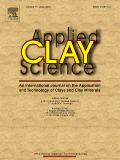
APPLIED CLAY SCIENCE
Scope & Guideline
Unveiling the Secrets of Clay for a Sustainable Future
Introduction
Aims and Scopes
- Clay Mineral Characterization:
Research often includes detailed investigations into the properties, structures, and behaviors of various clay minerals, assessing their suitability for specific applications. - Environmental Applications:
Studies focus on the use of clay materials for environmental remediation, including the adsorption of pollutants, heavy metals, and organic compounds from water and soil. - Synthesis and Modification of Clay-Based Materials:
The journal covers innovative synthesis techniques for clay minerals and their derivatives, including layered double hydroxides (LDHs), nanocomposites, and other modified forms for enhanced functionalities. - Geopolymers and Sustainable Materials:
Research highlights the role of clay materials in the development of geopolymers and other sustainable construction materials, exploring their mechanical properties, durability, and environmental impacts. - Nanotechnology in Clay Science:
There is a significant focus on nanotechnology applications involving clay minerals, including the development of nanocomposites and their use in various industrial applications. - Interfacial Chemistry and Interactions:
Papers often investigate the interactions at the molecular level between clay minerals and other materials, exploring how these interactions affect the overall properties and applications of the composites.
Trending and Emerging
- Advanced Catalytic Applications:
There is a growing focus on the use of layered double hydroxides and clay composites as catalysts in various chemical reactions, particularly in environmental remediation and energy applications. - Clay-Based Nanocomposites:
Research into nanocomposites incorporating clay minerals is on the rise, especially for applications in drug delivery, food packaging, and environmental remediation due to their unique properties. - Sustainable and Green Chemistry:
An increasing number of studies are dedicated to sustainable practices, including the use of clays in green chemistry applications, waste remediation, and the development of eco-friendly materials. - Biomedical Applications:
The use of clay materials in biomedical fields, such as drug delivery systems and tissue engineering, is emerging as a significant area of research, leveraging the unique properties of clays. - Climate Change and Environmental Impact Studies:
There is a notable increase in research exploring the role of clay minerals in climate change mitigation, including carbon capture and storage, as well as their impact on soil health and sustainability. - Smart and Responsive Materials:
The development of smart materials that respond to environmental stimuli using clay minerals is gaining attention, with applications in sensors, drug delivery, and adaptive systems.
Declining or Waning
- Traditional Clay Uses:
Research on traditional applications of clay in ceramics and pottery has seen a decline, as the journal increasingly emphasizes innovative and advanced applications. - Basic Physical Properties Studies:
Papers focused solely on the basic physical properties of clays, without application to modern technologies or environmental issues, have decreased in number, as the field moves towards more applied research. - Historical Perspectives on Clay Science:
There is less emphasis on historical studies or reviews of clay mineralogy, with a shift towards contemporary applications and future-oriented research. - Solely Mineralogical Studies:
Research that is purely mineralogical without a direct application or technological implication is becoming less common, as the journal seeks to highlight practical uses of clay materials.
Similar Journals
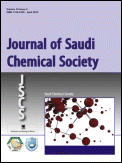
Journal of Saudi Chemical Society
Empowering Chemists Through Open Access Innovation.The Journal of Saudi Chemical Society, published by ELSEVIER, stands as a premier platform for advancing knowledge in the field of chemistry. Since its inception in 2009, this Open Access journal has garnered significant attention, securing a prestigious Q1 ranking in the Chemistry (miscellaneous) category for 2023, reflecting its position among the top journals in the discipline. With an impressive Scopus ranking of #66 out of 408 in General Chemistry, this journal boasts a commendable 83rd percentile, underscoring its impact and relevance in the global research community. The journal aims to disseminate high-quality research articles, reviews, and case studies, fostering innovation and collaboration among chemists and allied professionals. By enabling widespread access to cutting-edge research, the Journal of Saudi Chemical Society plays a crucial role in supporting the educational and professional development of students, researchers, and practitioners alike, making it an essential resource for anyone invested in the dynamic field of chemistry.

REVIEWS IN INORGANIC CHEMISTRY
Empowering Researchers with Invaluable InsightsREVIEWS IN INORGANIC CHEMISTRY, published by Walter de Gruyter GmbH, is a distinguished academic journal that serves as a vital resource for researchers, professionals, and students within the field of inorganic chemistry. With its ISSN 0193-4929 and E-ISSN 2191-0227, this journal has made a significant impact on the discipline, holding a commendable Q2 ranking in the 2023 category of Inorganic Chemistry, placing it in the 81st percentile among its peers according to Scopus rankings. Continuously published since its inception, with converged years spanning from 1985 to 1990 and 1992 to 2024, it features comprehensive reviews encompassing the latest advancements, methodologies, and theoretical frameworks in the subject. Researchers will find IDEAL insights and valuable discussions that keep them abreast of trends and challenges in the domain, essential for driving innovation and collaboration. The journal’s commitment to quality and rigorous peer review highlights its importance in advancing inorganic chemistry research, making it an indispensable tool for academic excellence.

Materials Research Express
Pioneering discussions on the properties and applications of materials.Materials Research Express is a leading open-access journal published by IOP Publishing Ltd, situated in the United Kingdom. Since its establishment in 2014, the journal has become an essential platform for researchers and professionals in the field of materials science, spanning several critical domains including biomaterials, metals and alloys, polymers, and electronic materials. With an open-access model adopted in 2020, Materials Research Express ensures that cutting-edge research is accessible to a global audience, enriching the dissemination of knowledge within the scientific community. The journal boasts impressive Scopus rankings, with a commendable position in various categories, such as 45th in Metals and Alloys and 51st in Surfaces, Coatings, and Films. This positions it well in the competitive landscape of materials science, fostering innovative discussions on material properties and applications. As the field continues to evolve, Materials Research Express aims to provide high-quality research and insights that address contemporary challenges and emerging technologies, making it an indispensable resource for academics and industry professionals alike.
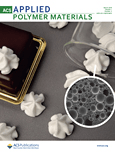
ACS Applied Polymer Materials
Elevating Knowledge in Polymer TechnologiesACS Applied Polymer Materials is a prestigious journal published by the American Chemical Society, specifically tailored for the dynamic fields of Organic Chemistry, Polymers and Plastics, and Process Chemistry and Technology. With its ISSN 2637-6105, the journal has rapidly established itself within the academic community, achieving a distinguished Q1 quartile ranking across multiple categories in 2023. This places it among the top-tier journals globally, reinforcing its critical role in disseminating groundbreaking research and innovation in polymer science. The journal is known for its rigorous peer-review process and publishes high-quality articles that are pivotal for researchers, professionals, and students eager to advance knowledge in polymer materials and their applications. Positioned to cover converging themes from 2019 through 2024, ACS Applied Polymer Materials embraces a wide scope of studies, from fundamental chemistry to practical engineering applications, thereby fostering significant advancements in material science. While it offers traditional access options, the journal's impact is reflected in its impressive rankings within Scopus, indicating its relevance and influence in the chemical engineering domain. Join the global community of innovators and discover the latest insights that continue to shape the landscape of applied polymer research.

JOURNAL OF SOL-GEL SCIENCE AND TECHNOLOGY
Shaping the Future of Materials EngineeringJOURNAL OF SOL-GEL SCIENCE AND TECHNOLOGY, published by Springer, is a vital resource within the interdisciplinary fields of materials science and engineering, focusing on innovative research related to sol-gel processes and applications. With a rich publication history spanning from 1993, this journal enables the dissemination of cutting-edge findings in biomaterials, ceramics, and composites, ranking impressively across various categories—Q3 in Biomaterials and Q2 in several other materials-related fields. The journal's commitment to quality research is reflected in its Scopus rankings, particularly notable in the categories of Condensed Matter Physics and Materials Chemistry. Researchers and professionals leveraging the insights from this journal are supported through its comprehensive scope, which bridges theoretical foundations with practical applications, advancing knowledge and fostering collaboration among academics and industry leaders alike. As a non-open access journal, it is essential for subscribers and institutions to engage deeply with the latest advancements documented within its pages, underscoring the journal's role in shaping the future of sol-gel science and technology.
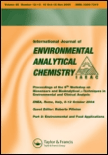
INTERNATIONAL JOURNAL OF ENVIRONMENTAL ANALYTICAL CHEMISTRY
Advancing the frontiers of environmental chemistry.INTERNATIONAL JOURNAL OF ENVIRONMENTAL ANALYTICAL CHEMISTRY, published by Taylor & Francis Ltd, stands as an essential resource in the interdisciplinary field of environmental science and analytical chemistry. With a history dating back to 1971 and a convergence period extending to 2024, this journal addresses urgent global challenges by providing a platform for high-quality research that encompasses pivotal aspects of environmental analysis, pollution, and public health. The journal’s significant impact is reflected in its 2023 rankings, placing it in the second and third quartiles across various relevant categories, including Analytical Chemistry, Environmental Chemistry, and Water Science and Technology. Researchers and practitioners are encouraged to contribute to its wealth of knowledge, making it a vital reference for emerging studies in Health, Toxicology and Mutagenesis and beyond. Although it is not an open-access journal, subscriptions provide unparalleled access to groundbreaking research that can influence both academia and industry practices.
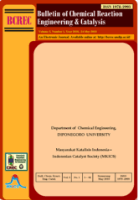
Bulletin of Chemical Reaction Engineering and Catalysis
Fostering Collaboration in Chemical Science DiscoveriesBulletin of Chemical Reaction Engineering and Catalysis is a distinguished open-access journal published by UNIV DIPONEGORO, focusing on pivotal advancements in the fields of chemical reaction engineering and catalysis. Since its inception in 2008, this journal has served as a vital platform for disseminating cutting-edge research, catering to a diverse readership that includes researchers, professionals, and students in chemical engineering and related disciplines. With its dedication to publishing valuable insights, the journal has been indexed in Scopus and boasts respectable rankings across various categories, including Q3 in Chemical Engineering (miscellaneous) and Q4 in Catalysis as of 2023. It continues to foster scholarly dialogue and collaboration by providing an accessible means for contributors to share their findings. Operating from Semarang, Indonesia, this journal underscores its commitment to advancing knowledge in chemical sciences, making it an essential resource for those engaged in the study and application of chemical processes.

INORGANIC MATERIALS
Fostering Collaboration in Inorganic Materials ExplorationINORGANIC MATERIALS, published by MAIK NAUKA/INTERPERIODICA/SPRINGER, is a pivotal journal in the realm of Materials Science, focusing primarily on the exploration and application of inorganic materials. With a robust commitment to advancing knowledge in areas such as Metals and Alloys, Inorganic Chemistry, and Chemical Engineering, this journal has successfully maintained a reputation for quality, achieving various category quartiles in 2023, including Q3 in Chemical Engineering and Materials Chemistry, and Q4 in Inorganic Chemistry. Although it operates under traditional access models, the journal welcomes contributions from researchers dedicated to understanding the properties and applications of inorganic substances. Throughout its publication history from 1996 to 2024, INORGANIC MATERIALS has become an essential resource for those engaged in innovative research and development, making it an invaluable tool for students, professionals, and academics alike.
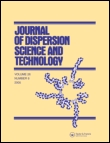
JOURNAL OF DISPERSION SCIENCE AND TECHNOLOGY
Connecting theory and practice in dispersion science.The Journal of Dispersion Science and Technology, published by Taylor & Francis Inc, stands as a vital resource in the fields of Physical and Theoretical Chemistry, Polymers and Plastics, and Surfaces, Coatings and Films. With an impressive history spanning over four decades, from 1980 to 2024, this journal plays a crucial role in advancing the understanding of dispersion science, emphasizing the intricacies of material interactions and their technological applications. Currently positioned in the Q2 and Q3 quartiles across relevant categories as of 2023, the journal demonstrates a robust impact within academic circles, reflected in its rankings: 49th in Materials Science - Surfaces, Coatings and Films and 63rd in Materials Science - Polymers and Plastics. Researchers, professionals, and students alike will find a wealth of innovative studies, comprehensive reviews, and experimental insights that contribute significantly to advancements in material science and technology. The journal's commitment to quality and rigor makes it an essential read for those seeking to stay at the forefront of these dynamic fields.

Physical and Chemical Aspects of the Study of Clusters Nanostructures and Nanomaterials
Decoding the Complexities of NanomaterialsPhysical and Chemical Aspects of the Study of Clusters, Nanostructures, and Nanomaterials is an esteemed open-access journal published by TVER STATE UNIVERSITY, dedicated to advancing the scientific discourse surrounding the intricate interplay of physical and chemical properties in nanostructure materials. Launched in 2017, this journal provides a vital platform for researchers, professionals, and students to disseminate and access cutting-edge findings in the rapidly evolving fields of nanotechnology and materials science. With an ISSN of 2226-4442 and an E-ISSN of 2658-4360, it aims to bridge the gap between academic research and practical applications. By facilitating open access to high-quality research, the journal plays an essential role in promoting innovative solutions to contemporary challenges in engineering, materials development, and related industries. The journal's scope includes but is not limited to the synthesis, characterization, and functionalization of nanomaterials, ensuring comprehensive coverage of this multidisciplinary field.